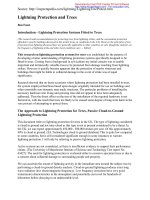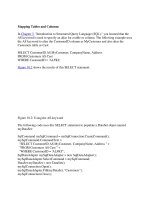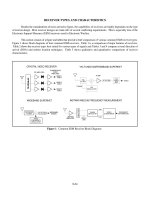Tài liệu Redistributing RIP and OSPF doc
Bạn đang xem bản rút gọn của tài liệu. Xem và tải ngay bản đầy đủ của tài liệu tại đây (30.93 KB, 5 trang )
1 - 5 Semester 5: Advanced Routing v2.0 - Lab 7.5.3 Copyright 2001, Cisco Systems, Inc.
7.5.3 Redistributing RIP and OSPF
S0/0 172.16.5.2/24 S0/1 172.16.7.1/24
S0/0 172.16.5.1/24 S0/0 172.16.7.2/24
Fa0/0 172.16.1.1/24 Fa0/0 172.16.8.1/24
SanJose1
Bay Point Vista
F0/0 192.168.1.1/24
Lo0 172.16.2.1/24
Lo1 172.16.3.1/24
Lo2 172.16.4.1/24
OSPF
AREA 0
RIPv1
Objective
In this lab, you configure mutual redistribution between RIPv1 and OSPF.
Scenario
International Travel Agency is adding two new sites to the San Jose campus. Baypointe
uses OSPF, and Vista supports only RIPv1 until you upgrade hardware. You have been
asked to configure mutual redistribution between the two protocols on the ASBR,
SanJose1. Routers in the RIPv1 domain should learn about OSPF networks, and routers
in the OSPF domain should learn about RIPv1 networks.
Step 1
Build and configure the network according to the diagram. Configure the loopback
interfaces with the IP addresses according to the map. The loopbacks will simulate
networks within each routing domain. Configure OSPF on Baypointe for all connected
networks, and RIPv1 on Vista for all connected networks. Do not configure routing on
SanJose1 yet.
Use show running-config to verify your work.
Step 2
Configure routing on SanJose1’s serial interfaces. Use the following commands to
configure SanJose1 routing processes:
SanJose1(config)#router rip
SanJose1(config-router)#network 172.16.0.0
SanJose1(config-router)#passive-interface serial0/0
SanJose1(config-router)#passive-interface fastetherent0/0
SanJose1(config-router)#router ospf 1
SanJose1(config-router)#network 172.16.5.0 0.0.0.3 area 0
1. Why are the passive interface statements applied to Serial0/0 and FastEthernet0/0
in RIP?
2 - 5 Semester 5: Advanced Routing v2.0 - Lab 7.5.3 Copyright 2001, Cisco Systems, Inc.
There are no other RIP hosts on those networks. Periodic RIP updates should be turned
off on all RIP-enabled interfaces that do not require them.
2. Why isn’t it necessary to configure any passive interfaces in the OSPF configuration?
Updates are sent and acknowledged between OSPF neighbors. If no OSPF adjacencies
are formed on a network, no OSPF updates are sent.
After you configure routing, check SanJose1’s routing table:
SanJose1#show ip route
Gateway of last resort is not set
172.16.0.0/16 is variably subnetted, 7 subnets, 3 masks
R 172.16.8.0/24 [120/1] via 172.16.7.2, 00:00:18, Serial0/1
O 172.16.4.1/32 [110/65] via 172.16.5.1, 00:03:20, Serial0/0
C 172.16.5.0/30 is directly connected, Serial0/0
C 172.16.7.0/24 is directly connected, Serial0/1
O 172.16.1.0/24 [110/65] via 172.16.5.1, 00:03:20, Serial0/0
O 172.16.3.1/32 [110/65] via 172.16.5.1, 00:03:20, Serial0/0
O 172.16.2.1/32 [110/65] via 172.16.5.1, 00:03:20, Serial0/0
C 192.168.1.0/24 is directly connected, FastEthernet0/0
SanJose1 should learn about Baypointe’s connected networks via OSPF and Vista’s
connected network via RIPv1. Troubleshoot, if necessary.
Now check Baypointe’s table:
BayPointe#show ip route
Gateway of last resort is not set
172.16.0.0/16 is variably subnetted, 5 subnets, 2 masks
C 172.16.4.0/24 is directly connected, Loopback2
C 172.16.5.0/30 is directly connected, Serial0/0
C 172.16.1.0/24 is directly connected, FastEthernet0/0
C 172.16.2.0/24 is directly connected, Loopback0
C 172.16.3.0/24 is directly connected, Loopback1
No dynamically learned routes should be present. Finally, check Vista’s table:
Vista#show ip route
Gateway of last resort is not set
172.16.0.0/24 is subnetted, 2 subnets
C 172.16.8.0 is directly connected, FastEthernet0/0
C 172.16.7.0 is directly connected, Serial0/0
3. Has Vista learned about any routes via RIPv1? Why?
Vista is directly connected to all RIPv1 networks, and redistribution has not been
configured.
3 - 5 Semester 5: Advanced Routing v2.0 - Lab 7.5.3 Copyright 2001, Cisco Systems, Inc.
Step 3
Configure redistribution on SanJose1 so that OSPF routes are injected into the RIPv1
process. Use the following commands to configure redistribution on SanJose1:
SanJose1(config)#router rip
SanJose1(config-router)#redistribute ospf 1
SanJose1(config-router)#default-metric 2
1. What is the default-metric command used for? Do you have to use it?
Check the routing table of Vista in the RIPv1 domain:
Vista#show ip route
Gateway of last resort is not set
172.16.0.0/16 is variably subnetted, 6 subnets, 2 masks
C 172.16.8.0/24 is directly connected, FastEthernet0/0
R 172.16.4.1/32 [120/2] via 172.16.7.1, 00:00:20, Serial0/0
C 172.16.7.0/24 is directly connected, Serial0/0
R 172.16.1.0/24 [120/2] via 172.16.7.1, 00:00:20, Serial0/0
R 172.16.3.1/32 [120/2] via 172.16.7.1, 00:00:20, Serial0/0
R 172.16.2.1/32 [120/2] via 172.16.7.1, 00:00:20, Serial0/0
2. Has Vista learned about any of the networks from the OSPF side?
Creating a seed metric can minimize routing loops or black holes in your network. RIP
can’t differentiate between internal and external (redistributed) routes. When a network’s
route is redistributed without a default metric, the network appears to be adjacent to the
autonomous system. Elevating the external default metric above any internal routes is a
crude but effective way of differentiating between internal and external routes.
3. What is the metric for each of these routes?
The metric should be 2.
Step 4
Configure redistribution on SanJose1 so that RIPv1 routes are injected into the OSPF
process. Use the following commands to configure mutual redistribution on SanJose1:
SanJose1(config)#router ospf 1
SanJose1(config-router)#redistribute rip
SanJose1(config-router)#default-metric 10
Check the routing table of Baypointe in the OSPF domain. Baypointe has not learned about
any of the networks from the RIPv1 side.
1. Why hasn’t Baypointe learned about any of the networks from the RIPv1 side?
4 - 5 Semester 5: Advanced Routing v2.0 - Lab 7.5.3 Copyright 2001, Cisco Systems, Inc.
Baypointe should not have any new routes in its routing table. That’s because OSPF will
not redistribute routes to RIP subnets unless explicitly configured with the subnets
keyword. Return to SanJose1 and enter the following configuration:
SanJose1(config)#router ospf 1
SanJose1(config-router)#redistribute rip subnets
After you enter these commands, check Baypointe’s table again:
BayPointe#show ip route
Gateway of last resort is not set
172.16.0.0/16 is variably subnetted, 7 subnets, 2 masks
O E2 172.16.8.0/24 [110/10] via 172.16.5.2, 00:00:07, Serial0/0
C 172.16.4.0/24 is directly connected, Loopback2
C 172.16.5.0/30 is directly connected, Serial0/0
O E2 172.16.7.0/24 [110/10] via 172.16.5.2, 00:00:07, Serial0/0
C 172.16.1.0/24 is directly connected, FastEthernet0/0
C 172.16.2.0/24 is directly connected, Loopback0
C 172.16.3.0/24 is directly connected, Loopback1
2. Has Baypointe learned about the routes from the RIPv1 domain? What is the metric for
these routes?
The metric should be 10.
In the routing table, you will see the redistributed routes tagged with the characters “E2.”
3. What do these characters mean?
Recall that Type 2 (E2) routes originated outside the OSPF AS and were redistributed
into OSPF using Type 5 or Type 7 LSA.
Step 5
Look carefully at Baypointe’s table.
1. Is there a route to 192.168.1.0 /24?
2. Does Vista have a route to 192.168.1.0 /24?
3. Why is this route missing from Baypointe’s table?
Interface FastEthernet0/0 on SanJose1 is not enabled for either OSPF or RIPv1.
You can complete Baypointe’s table by configuring SanJose1 to redistribute connected
routes into OSPF:
SanJose1(config)#router ospf 1
SanJose1(config-router)#redistribute connected subnets
5 - 5 Semester 5: Advanced Routing v2.0 - Lab 7.5.3 Copyright 2001, Cisco Systems, Inc.
4. What will be the seed metric for redistributed connected routes?
The OSPF default metric was previously set to 10.
Also, configure SanJose1’s RIPv1 process to redistribute the connected route:
SanJose1(config)#router rip
SanJose1(config-router)#redistribute connected
Check the routing tables a final time. Baypointe and SanJose1 should contain all routes.
BayPointe#show ip route
Gateway of last resort is not set
172.16.0.0/16 is variably subnetted, 7 subnets, 2 masks
O E2 172.16.8.0/24 [110/10] via 172.16.5.2, 00:02:00, Serial0/0
C 172.16.4.0/24 is directly connected, Loopback2
C 172.16.5.0/30 is directly connected, Serial0/0
O E2 172.16.7.0/24 [110/20] via 172.16.5.2, 00:01:08, Serial0/0
C 172.16.1.0/24 is directly connected, FastEthernet0/0
C 172.16.2.0/24 is directly connected, Loopback0
C 172.16.3.0/24 is directly connected, Loopback1
O E2 192.168.1.0/24 [110/20] via 172.16.5.2, 00:01:08, Serial0/0
SanJose1#show ip route
Gateway of last resort is not set
172.16.0.0/16 is variably subnetted, 7 subnets, 3 masks
R 172.16.8.0/24 [120/1] via 172.16.7.2, 00:00:07, Serial0/1
O 172.16.4.1/32 [110/65] via 172.16.5.1, 00:04:06, Serial0/0
C 172.16.5.0/30 is directly connected, Serial0/0
C 172.16.7.0/24 is directly connected, Serial0/1
O 172.16.1.0/24 [110/65] via 172.16.5.1, 00:04:06, Serial0/0
O 172.16.3.1/32 [110/65] via 172.16.5.1, 00:04:06, Serial0/0
O 172.16.2.1/32 [110/65] via 172.16.5.1, 00:04:06, Serial0/0
C 192.168.1.0/24 is directly connected, FastEthernet0/0
Vista#show ip route
Gateway of last resort is not set
172.16.0.0/16 is variably subnetted, 6 subnets, 2 masks
C 172.16.8.0/24 is directly connected, FastEthernet0/0
R 172.16.4.1/32 [120/2] via 172.16.7.1, 00:00:22, Serial0/0
C 172.16.7.0/24 is directly connected, Serial0/0
R 172.16.1.0/24 [120/2] via 172.16.7.1, 00:00:22, Serial0/0
R 172.16.3.1/32 [120/2] via 172.16.7.1, 00:00:22, Serial0/0
R 172.16.2.1/32 [120/2] via 172.16.7.1, 00:00:22, Serial0/0
R 192.168.1.0/24 [120/1] via 172.16.7.1, 00:00:22, Serial0/0
Vista will not have a route to 172.16.5.0/30, because 172.16.0.0 is variably subnetted and RIPv1
does not support VLSM. The /32 networks you see are allowed by the ip classless command
to support default networks in RIP and IGRP.









